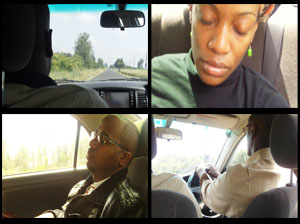I left my place at 4:30 in the morning to join Caleb for a feature on a guy who was buying crocodiles. Unfortunately, we had to postpone the story and Caleb ended up meeting a guy who owns 500 dogs. The day turned into a road trip. From Nairobi to Naivasha to Njoro in Nakuru District of Rift Valley Province. I was accompanied by Caleb, a K24 camera guy named JP (he’s from Rwanda), and our driver, Jesse.
After meeting the dog guy (and confronting my discomfort of aggressive dogs), we went to Lord Egerton Castle in the beautiful Kenyan countryside of Rift Valley Province. I had never heard the story, but apparently, it’s well-known here. British nobleman, Fourth Baron Lord Maurice Egerton of Tatton, arrived in Kenya in 1927 and fell in love with the country. Here, he built a symbol of love for the lady in his heart.
 He wanted a structure that would have no comparison in England. His fiancée visited him from England and did not like the
He wanted a structure that would have no comparison in England. His fiancée visited him from England and did not like the  humble cottage that Egerton had built for her, referring to it as a “bird’s nest.” So, in the late 1930’s, he began constructing another structure, a 53-roomed building adjacent to the first one. The second building, magnificent and stoned in grandeur, was completed in 1954. She again rejected his gift and went back to the UK to marry another man. Heartbroken, Lord Egerton banned all women from the castle and he never married. According to the current caretaker, 76-year- old Robert Onyiego (former employee of Lord Egerton), Egerton did everything he could to avoid women. Only men were employed at the castle. Before he died in his Kenyan home on January 30 1958, Egerton had sold the estate to the Kenyan government. The barony ended because Egerton left no heir to carry the family name.
humble cottage that Egerton had built for her, referring to it as a “bird’s nest.” So, in the late 1930’s, he began constructing another structure, a 53-roomed building adjacent to the first one. The second building, magnificent and stoned in grandeur, was completed in 1954. She again rejected his gift and went back to the UK to marry another man. Heartbroken, Lord Egerton banned all women from the castle and he never married. According to the current caretaker, 76-year- old Robert Onyiego (former employee of Lord Egerton), Egerton did everything he could to avoid women. Only men were employed at the castle. Before he died in his Kenyan home on January 30 1958, Egerton had sold the estate to the Kenyan government. The barony ended because Egerton left no heir to carry the family name.
The property is now owned by Egerton University’s Njoro campus. (Note, Egerton referred to the estate as a hunting lodge, but the local Kenyans called it a castle.) The estate was made open to the public in 2005.
It’s a beautiful estate, with a colorful garden on all its side. Softly rolling hills stand in the background. One of the ladies who tended the place said they are trying to promote it for parties and such. I asked her how much it would cost to do a wedding. She said Ksh10,000. That’s less than USD $125, for a wedding in a castle! Strangely, the name of the woman who rejected Egerton’s proposal has never been published in any accounts of Egerton’s life.
Driving throughout Kenya, my heart swelled. I’m really beginning to like this country. The smiles, the curious faces, everyone, I mean everyone, looks in your car, and everyone says “Karibu Sana” (You are very welcome). Caleb and JP explained what I was seeing. We stopped in Naivasha, where Caleb said one must buy yogurt. I love yogurt, but this yogurt was a bit too rich. 100% whole milk. But I did enjoy lunch, mukimo, a traditional Kikuyu dish made from pumpkin leaves and maize. It’s really healthy, as most Kenyan food is. My only issue is that Kenyans don’t really use pepper and I looooooove spicy dishes.
We stopped to see the famous Great Rift Valley. I later learned that the rift actually runs from central Mozambique to Lebanon. But the term, Great Rift Valley is usually used to describe the valley in East Africa. It’s home to several lakes and springs. Scientists have found fossils in these areas which lead many anthropologists to believe that the first humans on Earth lived along these bodies of water. And some of Africa’s highest mountains surround this area. I, personally, loved the gentleness of the valley.
Overlooking the land behind a multicolored gate, I was bombarded by traders selling craft wares. And lured by the wooden figures, I spent Ksh5,000 (not much money, really) on little sculptures: a giraffe, a rhino, a hippo and the perfect gift for my best friend.








